MSN Thesis Proposal: Majmaah University Nursing Leadership
VerifiedAdded on 2022/09/08
|29
|6033
|12
Project
AI Summary
This MSN thesis proposal investigates the impact of communication between nursing managers and staff in the Riyadh region. The research aims to evaluate how communication affects patient outcomes, medication errors, quality of care, and job satisfaction. The proposal outlines the background, aims, objectives, and hypothesis, emphasizing the significance of effective communication in overcoming challenges in the nursing workforce, particularly in Saudi Arabia. The study employs the Dyadic Interpersonal Communication Model as its theoretical framework and reviews related studies to support its objectives. The methods section details the research design, sample, instruments, data collection, and analysis, along with ethical considerations and limitations. The proposal utilizes questionnaires such as QUALPAC, CSAS, and MMSS to assess the impact of communication. The study is significant as it addresses challenges in nursing, such as workforce shortages, cultural diversity, and the need for improved communication to enhance patient care and nurse satisfaction.
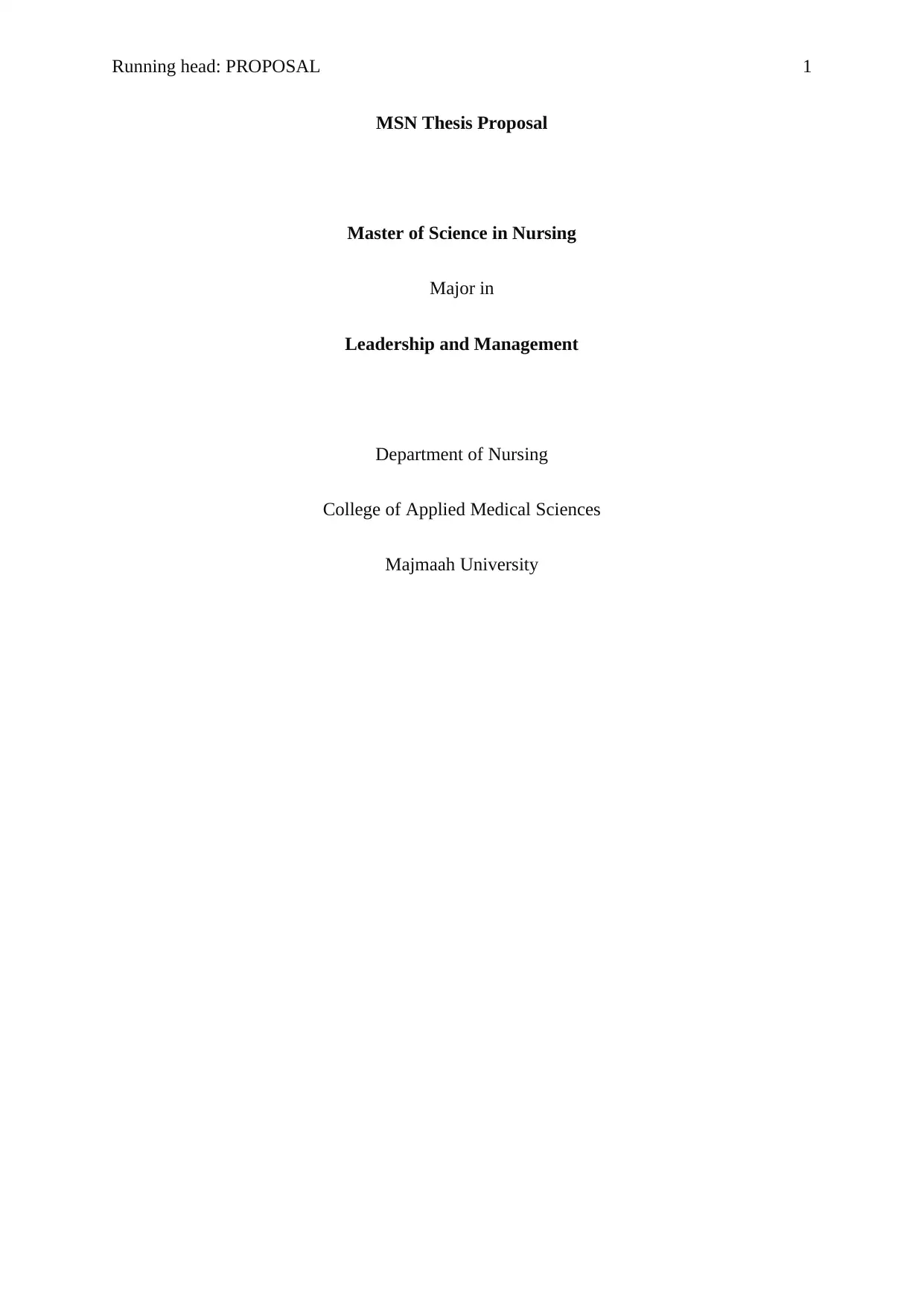
Running head: PROPOSAL 1
MSN Thesis Proposal
Master of Science in Nursing
Major in
Leadership and Management
Department of Nursing
College of Applied Medical Sciences
Majmaah University
MSN Thesis Proposal
Master of Science in Nursing
Major in
Leadership and Management
Department of Nursing
College of Applied Medical Sciences
Majmaah University
Paraphrase This Document
Need a fresh take? Get an instant paraphrase of this document with our AI Paraphraser
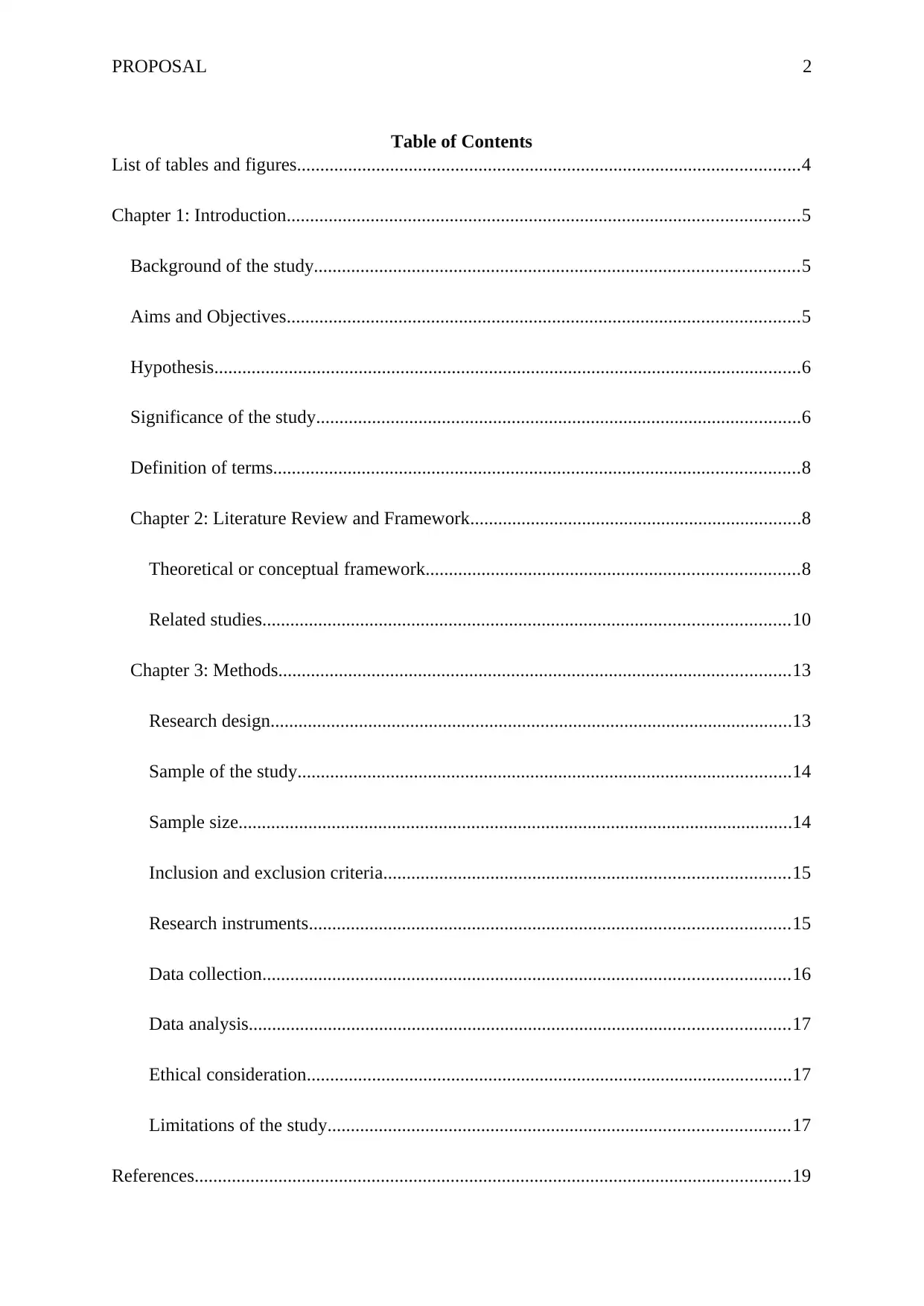
PROPOSAL 2
Table of Contents
List of tables and figures............................................................................................................4
Chapter 1: Introduction..............................................................................................................5
Background of the study........................................................................................................5
Aims and Objectives..............................................................................................................5
Hypothesis..............................................................................................................................6
Significance of the study........................................................................................................6
Definition of terms.................................................................................................................8
Chapter 2: Literature Review and Framework.......................................................................8
Theoretical or conceptual framework................................................................................8
Related studies.................................................................................................................10
Chapter 3: Methods..............................................................................................................13
Research design................................................................................................................13
Sample of the study..........................................................................................................14
Sample size.......................................................................................................................14
Inclusion and exclusion criteria.......................................................................................15
Research instruments.......................................................................................................15
Data collection.................................................................................................................16
Data analysis....................................................................................................................17
Ethical consideration........................................................................................................17
Limitations of the study...................................................................................................17
References................................................................................................................................19
Table of Contents
List of tables and figures............................................................................................................4
Chapter 1: Introduction..............................................................................................................5
Background of the study........................................................................................................5
Aims and Objectives..............................................................................................................5
Hypothesis..............................................................................................................................6
Significance of the study........................................................................................................6
Definition of terms.................................................................................................................8
Chapter 2: Literature Review and Framework.......................................................................8
Theoretical or conceptual framework................................................................................8
Related studies.................................................................................................................10
Chapter 3: Methods..............................................................................................................13
Research design................................................................................................................13
Sample of the study..........................................................................................................14
Sample size.......................................................................................................................14
Inclusion and exclusion criteria.......................................................................................15
Research instruments.......................................................................................................15
Data collection.................................................................................................................16
Data analysis....................................................................................................................17
Ethical consideration........................................................................................................17
Limitations of the study...................................................................................................17
References................................................................................................................................19
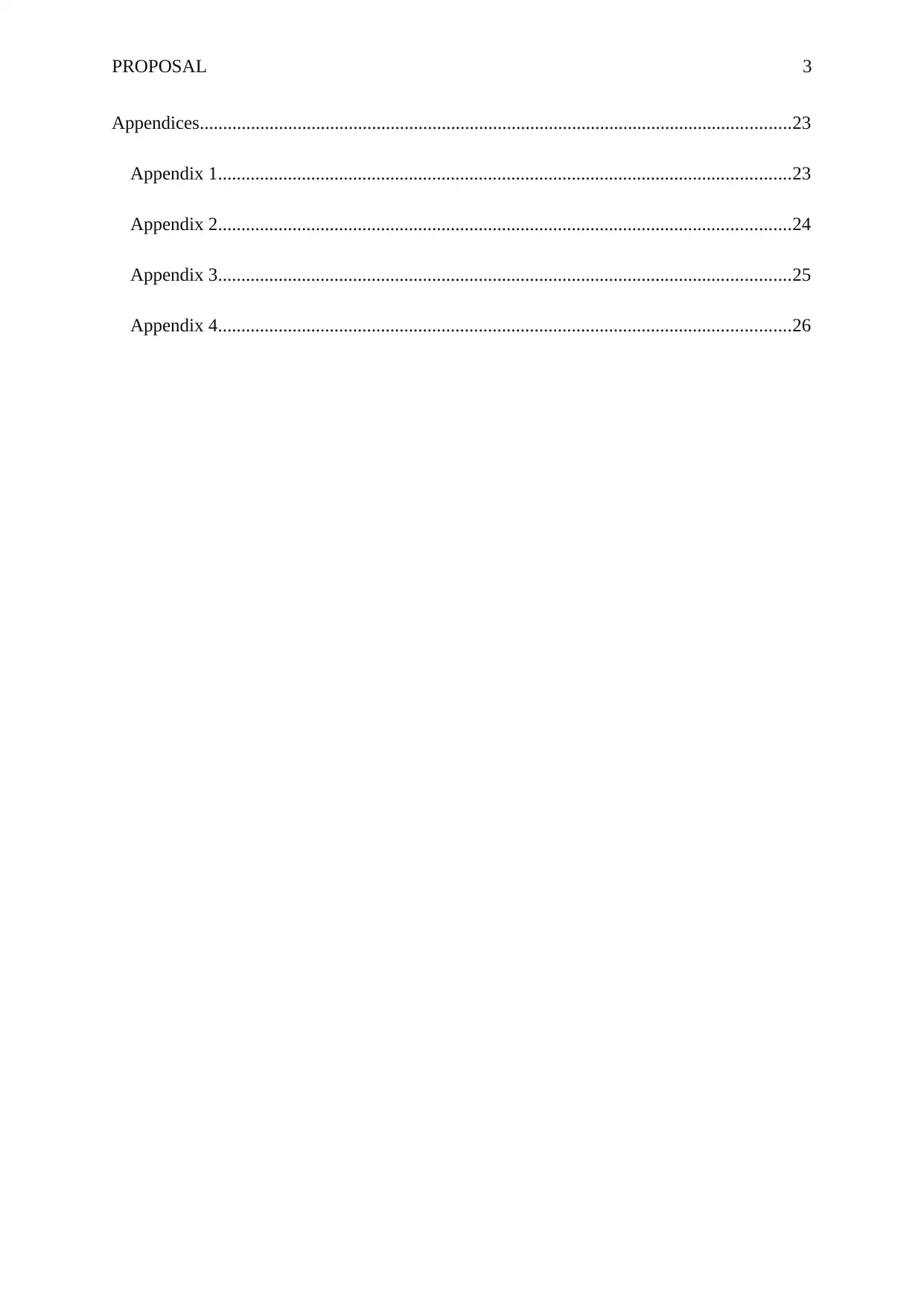
PROPOSAL 3
Appendices...............................................................................................................................23
Appendix 1...........................................................................................................................23
Appendix 2...........................................................................................................................24
Appendix 3...........................................................................................................................25
Appendix 4...........................................................................................................................26
Appendices...............................................................................................................................23
Appendix 1...........................................................................................................................23
Appendix 2...........................................................................................................................24
Appendix 3...........................................................................................................................25
Appendix 4...........................................................................................................................26
⊘ This is a preview!⊘
Do you want full access?
Subscribe today to unlock all pages.

Trusted by 1+ million students worldwide
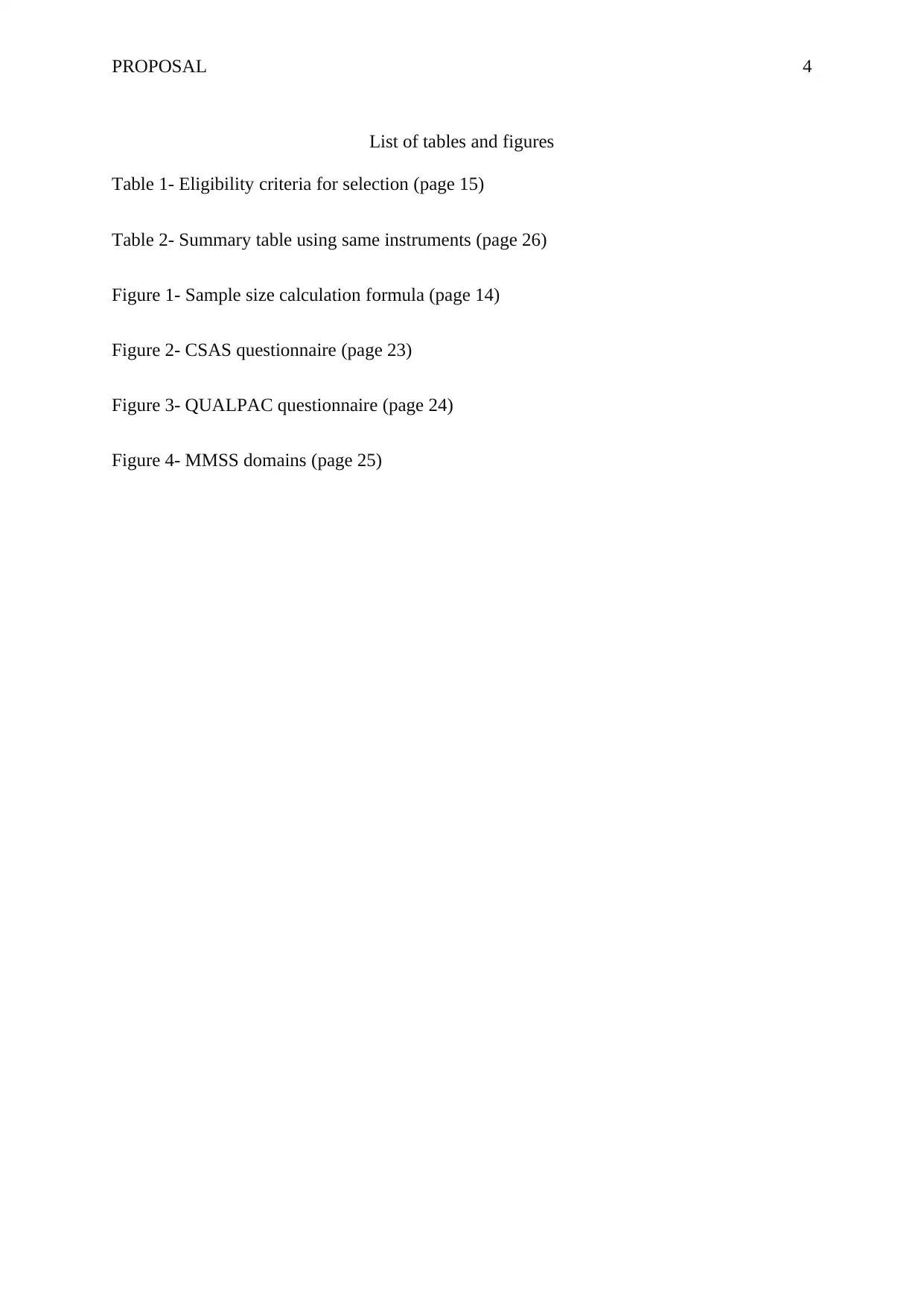
PROPOSAL 4
List of tables and figures
Table 1- Eligibility criteria for selection (page 15)
Table 2- Summary table using same instruments (page 26)
Figure 1- Sample size calculation formula (page 14)
Figure 2- CSAS questionnaire (page 23)
Figure 3- QUALPAC questionnaire (page 24)
Figure 4- MMSS domains (page 25)
List of tables and figures
Table 1- Eligibility criteria for selection (page 15)
Table 2- Summary table using same instruments (page 26)
Figure 1- Sample size calculation formula (page 14)
Figure 2- CSAS questionnaire (page 23)
Figure 3- QUALPAC questionnaire (page 24)
Figure 4- MMSS domains (page 25)
Paraphrase This Document
Need a fresh take? Get an instant paraphrase of this document with our AI Paraphraser
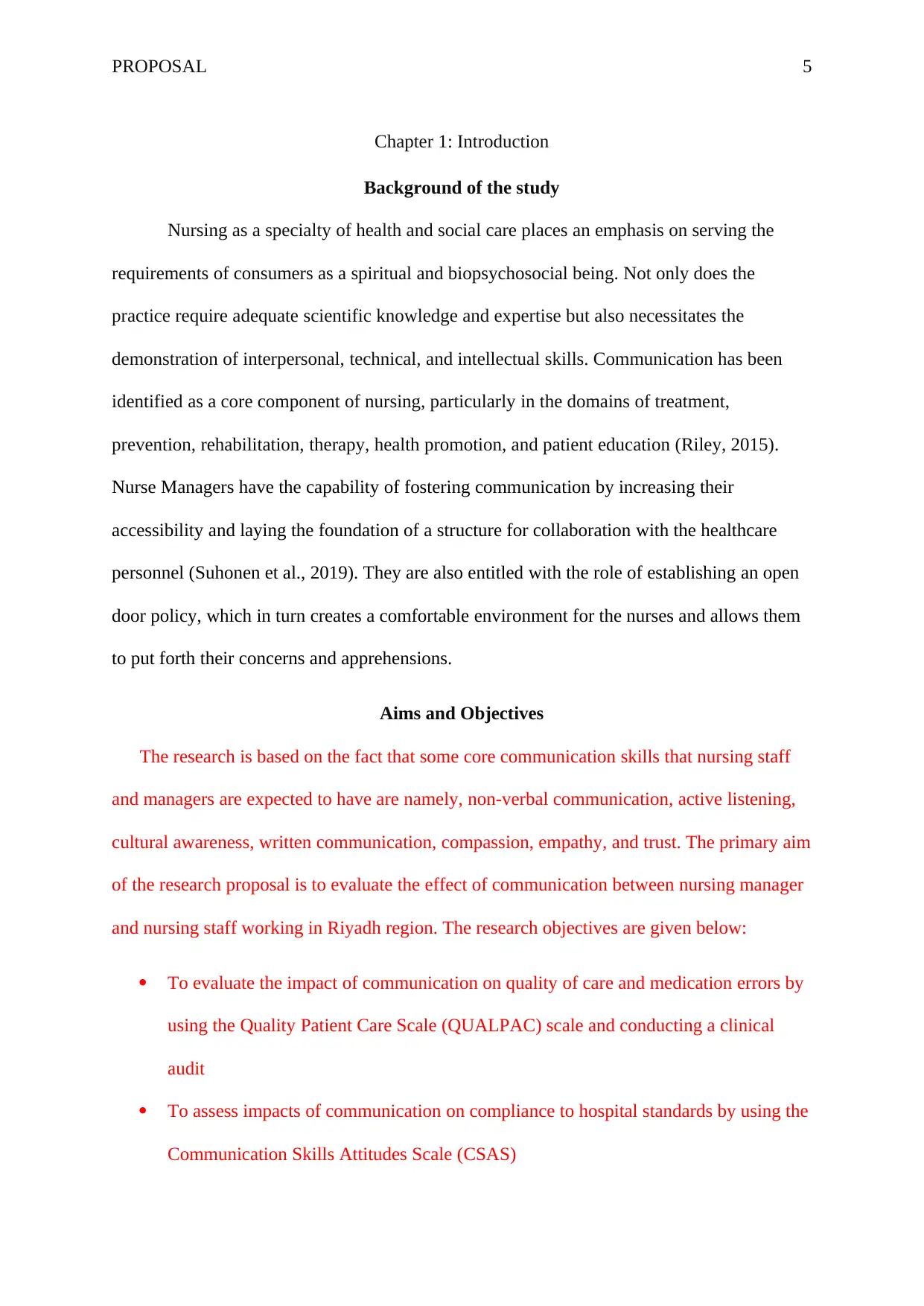
PROPOSAL 5
Chapter 1: Introduction
Background of the study
Nursing as a specialty of health and social care places an emphasis on serving the
requirements of consumers as a spiritual and biopsychosocial being. Not only does the
practice require adequate scientific knowledge and expertise but also necessitates the
demonstration of interpersonal, technical, and intellectual skills. Communication has been
identified as a core component of nursing, particularly in the domains of treatment,
prevention, rehabilitation, therapy, health promotion, and patient education (Riley, 2015).
Nurse Managers have the capability of fostering communication by increasing their
accessibility and laying the foundation of a structure for collaboration with the healthcare
personnel (Suhonen et al., 2019). They are also entitled with the role of establishing an open
door policy, which in turn creates a comfortable environment for the nurses and allows them
to put forth their concerns and apprehensions.
Aims and Objectives
The research is based on the fact that some core communication skills that nursing staff
and managers are expected to have are namely, non-verbal communication, active listening,
cultural awareness, written communication, compassion, empathy, and trust. The primary aim
of the research proposal is to evaluate the effect of communication between nursing manager
and nursing staff working in Riyadh region. The research objectives are given below:
To evaluate the impact of communication on quality of care and medication errors by
using the Quality Patient Care Scale (QUALPAC) scale and conducting a clinical
audit
To assess impacts of communication on compliance to hospital standards by using the
Communication Skills Attitudes Scale (CSAS)
Chapter 1: Introduction
Background of the study
Nursing as a specialty of health and social care places an emphasis on serving the
requirements of consumers as a spiritual and biopsychosocial being. Not only does the
practice require adequate scientific knowledge and expertise but also necessitates the
demonstration of interpersonal, technical, and intellectual skills. Communication has been
identified as a core component of nursing, particularly in the domains of treatment,
prevention, rehabilitation, therapy, health promotion, and patient education (Riley, 2015).
Nurse Managers have the capability of fostering communication by increasing their
accessibility and laying the foundation of a structure for collaboration with the healthcare
personnel (Suhonen et al., 2019). They are also entitled with the role of establishing an open
door policy, which in turn creates a comfortable environment for the nurses and allows them
to put forth their concerns and apprehensions.
Aims and Objectives
The research is based on the fact that some core communication skills that nursing staff
and managers are expected to have are namely, non-verbal communication, active listening,
cultural awareness, written communication, compassion, empathy, and trust. The primary aim
of the research proposal is to evaluate the effect of communication between nursing manager
and nursing staff working in Riyadh region. The research objectives are given below:
To evaluate the impact of communication on quality of care and medication errors by
using the Quality Patient Care Scale (QUALPAC) scale and conducting a clinical
audit
To assess impacts of communication on compliance to hospital standards by using the
Communication Skills Attitudes Scale (CSAS)
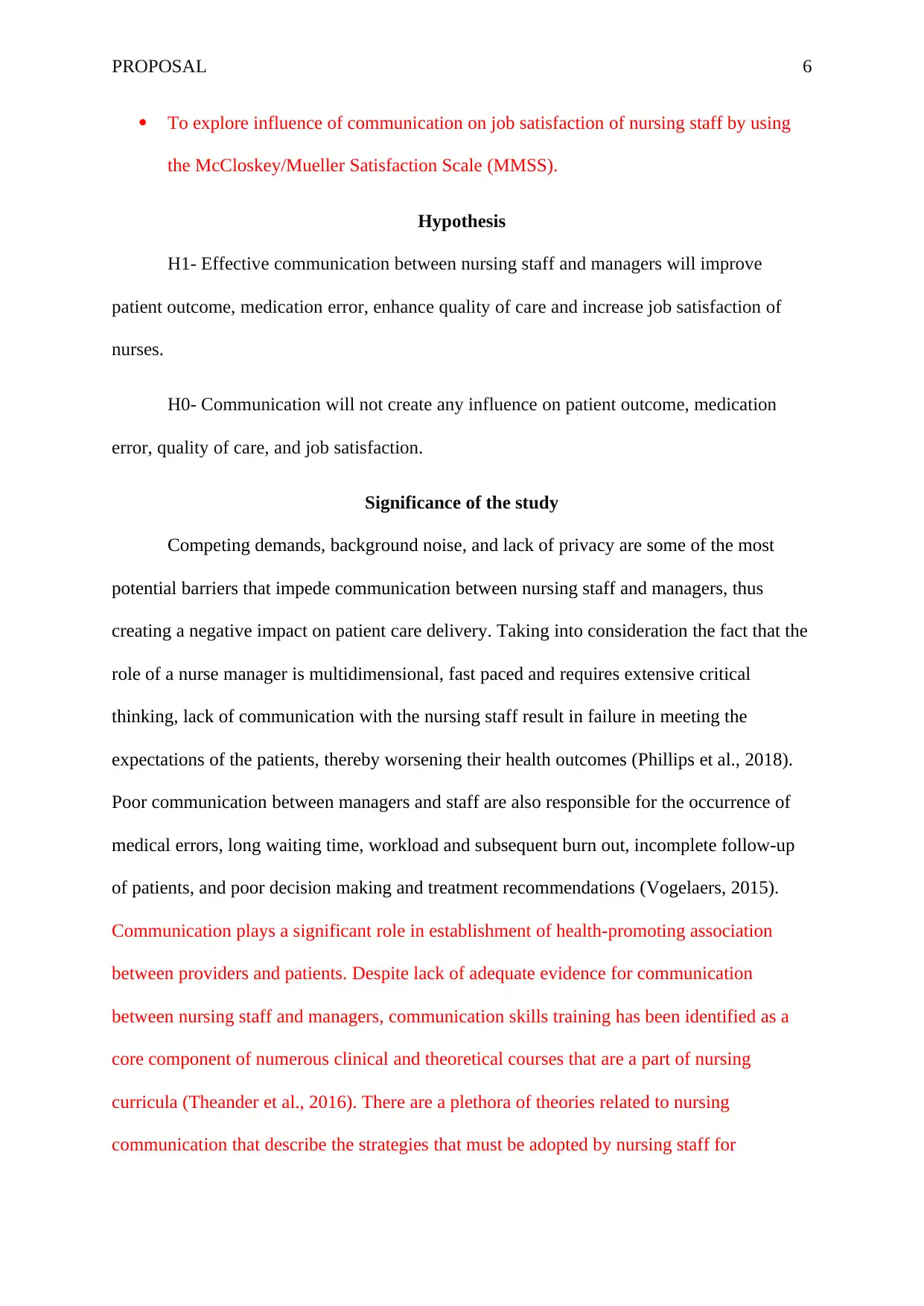
PROPOSAL 6
To explore influence of communication on job satisfaction of nursing staff by using
the McCloskey/Mueller Satisfaction Scale (MMSS).
Hypothesis
H1- Effective communication between nursing staff and managers will improve
patient outcome, medication error, enhance quality of care and increase job satisfaction of
nurses.
H0- Communication will not create any influence on patient outcome, medication
error, quality of care, and job satisfaction.
Significance of the study
Competing demands, background noise, and lack of privacy are some of the most
potential barriers that impede communication between nursing staff and managers, thus
creating a negative impact on patient care delivery. Taking into consideration the fact that the
role of a nurse manager is multidimensional, fast paced and requires extensive critical
thinking, lack of communication with the nursing staff result in failure in meeting the
expectations of the patients, thereby worsening their health outcomes (Phillips et al., 2018).
Poor communication between managers and staff are also responsible for the occurrence of
medical errors, long waiting time, workload and subsequent burn out, incomplete follow-up
of patients, and poor decision making and treatment recommendations (Vogelaers, 2015).
Communication plays a significant role in establishment of health-promoting association
between providers and patients. Despite lack of adequate evidence for communication
between nursing staff and managers, communication skills training has been identified as a
core component of numerous clinical and theoretical courses that are a part of nursing
curricula (Theander et al., 2016). There are a plethora of theories related to nursing
communication that describe the strategies that must be adopted by nursing staff for
To explore influence of communication on job satisfaction of nursing staff by using
the McCloskey/Mueller Satisfaction Scale (MMSS).
Hypothesis
H1- Effective communication between nursing staff and managers will improve
patient outcome, medication error, enhance quality of care and increase job satisfaction of
nurses.
H0- Communication will not create any influence on patient outcome, medication
error, quality of care, and job satisfaction.
Significance of the study
Competing demands, background noise, and lack of privacy are some of the most
potential barriers that impede communication between nursing staff and managers, thus
creating a negative impact on patient care delivery. Taking into consideration the fact that the
role of a nurse manager is multidimensional, fast paced and requires extensive critical
thinking, lack of communication with the nursing staff result in failure in meeting the
expectations of the patients, thereby worsening their health outcomes (Phillips et al., 2018).
Poor communication between managers and staff are also responsible for the occurrence of
medical errors, long waiting time, workload and subsequent burn out, incomplete follow-up
of patients, and poor decision making and treatment recommendations (Vogelaers, 2015).
Communication plays a significant role in establishment of health-promoting association
between providers and patients. Despite lack of adequate evidence for communication
between nursing staff and managers, communication skills training has been identified as a
core component of numerous clinical and theoretical courses that are a part of nursing
curricula (Theander et al., 2016). There are a plethora of theories related to nursing
communication that describe the strategies that must be adopted by nursing staff for
⊘ This is a preview!⊘
Do you want full access?
Subscribe today to unlock all pages.

Trusted by 1+ million students worldwide
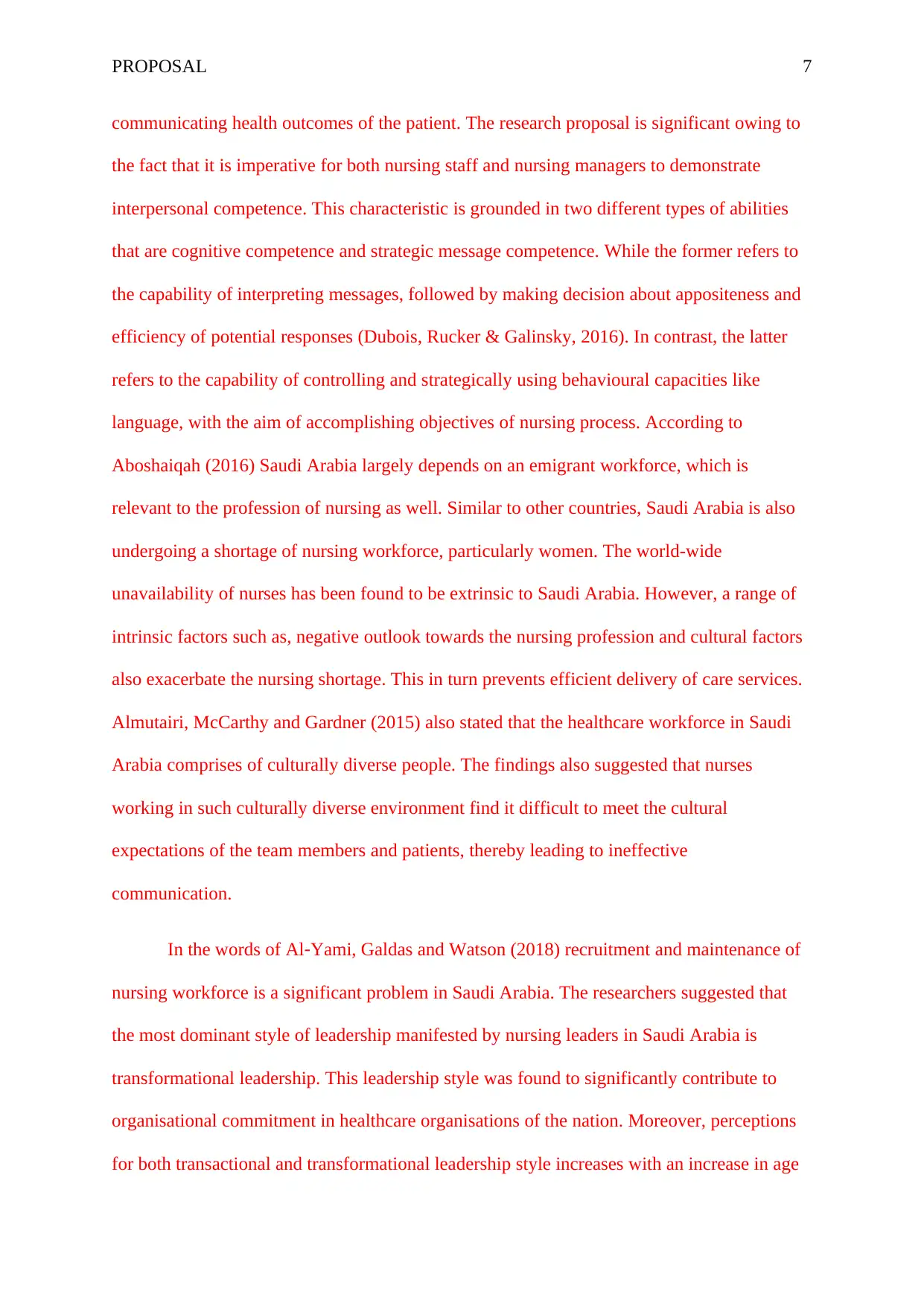
PROPOSAL 7
communicating health outcomes of the patient. The research proposal is significant owing to
the fact that it is imperative for both nursing staff and nursing managers to demonstrate
interpersonal competence. This characteristic is grounded in two different types of abilities
that are cognitive competence and strategic message competence. While the former refers to
the capability of interpreting messages, followed by making decision about appositeness and
efficiency of potential responses (Dubois, Rucker & Galinsky, 2016). In contrast, the latter
refers to the capability of controlling and strategically using behavioural capacities like
language, with the aim of accomplishing objectives of nursing process. According to
Aboshaiqah (2016) Saudi Arabia largely depends on an emigrant workforce, which is
relevant to the profession of nursing as well. Similar to other countries, Saudi Arabia is also
undergoing a shortage of nursing workforce, particularly women. The world-wide
unavailability of nurses has been found to be extrinsic to Saudi Arabia. However, a range of
intrinsic factors such as, negative outlook towards the nursing profession and cultural factors
also exacerbate the nursing shortage. This in turn prevents efficient delivery of care services.
Almutairi, McCarthy and Gardner (2015) also stated that the healthcare workforce in Saudi
Arabia comprises of culturally diverse people. The findings also suggested that nurses
working in such culturally diverse environment find it difficult to meet the cultural
expectations of the team members and patients, thereby leading to ineffective
communication.
In the words of Al‐Yami, Galdas and Watson (2018) recruitment and maintenance of
nursing workforce is a significant problem in Saudi Arabia. The researchers suggested that
the most dominant style of leadership manifested by nursing leaders in Saudi Arabia is
transformational leadership. This leadership style was found to significantly contribute to
organisational commitment in healthcare organisations of the nation. Moreover, perceptions
for both transactional and transformational leadership style increases with an increase in age
communicating health outcomes of the patient. The research proposal is significant owing to
the fact that it is imperative for both nursing staff and nursing managers to demonstrate
interpersonal competence. This characteristic is grounded in two different types of abilities
that are cognitive competence and strategic message competence. While the former refers to
the capability of interpreting messages, followed by making decision about appositeness and
efficiency of potential responses (Dubois, Rucker & Galinsky, 2016). In contrast, the latter
refers to the capability of controlling and strategically using behavioural capacities like
language, with the aim of accomplishing objectives of nursing process. According to
Aboshaiqah (2016) Saudi Arabia largely depends on an emigrant workforce, which is
relevant to the profession of nursing as well. Similar to other countries, Saudi Arabia is also
undergoing a shortage of nursing workforce, particularly women. The world-wide
unavailability of nurses has been found to be extrinsic to Saudi Arabia. However, a range of
intrinsic factors such as, negative outlook towards the nursing profession and cultural factors
also exacerbate the nursing shortage. This in turn prevents efficient delivery of care services.
Almutairi, McCarthy and Gardner (2015) also stated that the healthcare workforce in Saudi
Arabia comprises of culturally diverse people. The findings also suggested that nurses
working in such culturally diverse environment find it difficult to meet the cultural
expectations of the team members and patients, thereby leading to ineffective
communication.
In the words of Al‐Yami, Galdas and Watson (2018) recruitment and maintenance of
nursing workforce is a significant problem in Saudi Arabia. The researchers suggested that
the most dominant style of leadership manifested by nursing leaders in Saudi Arabia is
transformational leadership. This leadership style was found to significantly contribute to
organisational commitment in healthcare organisations of the nation. Moreover, perceptions
for both transactional and transformational leadership style increases with an increase in age
Paraphrase This Document
Need a fresh take? Get an instant paraphrase of this document with our AI Paraphraser
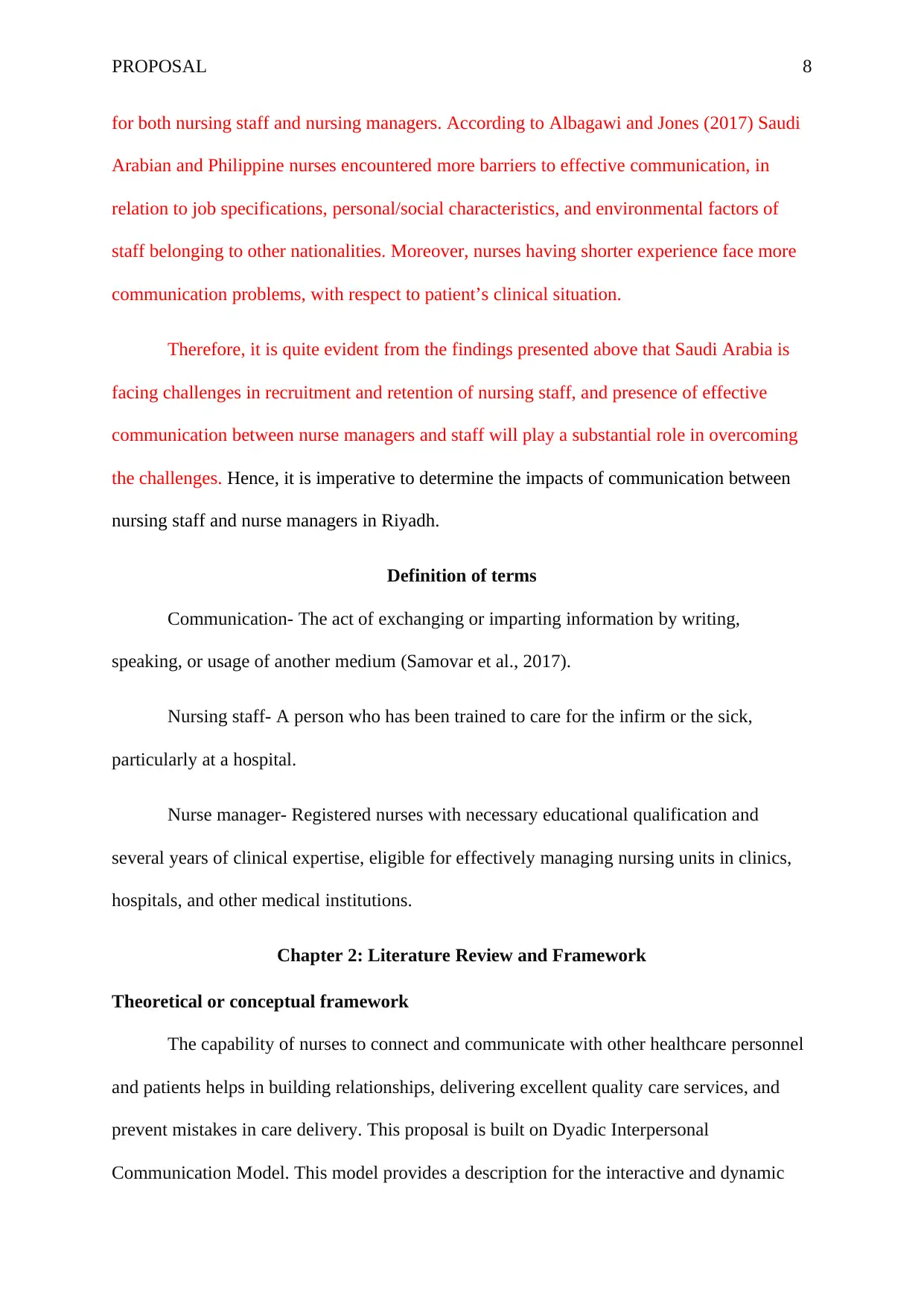
PROPOSAL 8
for both nursing staff and nursing managers. According to Albagawi and Jones (2017) Saudi
Arabian and Philippine nurses encountered more barriers to effective communication, in
relation to job specifications, personal/social characteristics, and environmental factors of
staff belonging to other nationalities. Moreover, nurses having shorter experience face more
communication problems, with respect to patient’s clinical situation.
Therefore, it is quite evident from the findings presented above that Saudi Arabia is
facing challenges in recruitment and retention of nursing staff, and presence of effective
communication between nurse managers and staff will play a substantial role in overcoming
the challenges. Hence, it is imperative to determine the impacts of communication between
nursing staff and nurse managers in Riyadh.
Definition of terms
Communication- The act of exchanging or imparting information by writing,
speaking, or usage of another medium (Samovar et al., 2017).
Nursing staff- A person who has been trained to care for the infirm or the sick,
particularly at a hospital.
Nurse manager- Registered nurses with necessary educational qualification and
several years of clinical expertise, eligible for effectively managing nursing units in clinics,
hospitals, and other medical institutions.
Chapter 2: Literature Review and Framework
Theoretical or conceptual framework
The capability of nurses to connect and communicate with other healthcare personnel
and patients helps in building relationships, delivering excellent quality care services, and
prevent mistakes in care delivery. This proposal is built on Dyadic Interpersonal
Communication Model. This model provides a description for the interactive and dynamic
for both nursing staff and nursing managers. According to Albagawi and Jones (2017) Saudi
Arabian and Philippine nurses encountered more barriers to effective communication, in
relation to job specifications, personal/social characteristics, and environmental factors of
staff belonging to other nationalities. Moreover, nurses having shorter experience face more
communication problems, with respect to patient’s clinical situation.
Therefore, it is quite evident from the findings presented above that Saudi Arabia is
facing challenges in recruitment and retention of nursing staff, and presence of effective
communication between nurse managers and staff will play a substantial role in overcoming
the challenges. Hence, it is imperative to determine the impacts of communication between
nursing staff and nurse managers in Riyadh.
Definition of terms
Communication- The act of exchanging or imparting information by writing,
speaking, or usage of another medium (Samovar et al., 2017).
Nursing staff- A person who has been trained to care for the infirm or the sick,
particularly at a hospital.
Nurse manager- Registered nurses with necessary educational qualification and
several years of clinical expertise, eligible for effectively managing nursing units in clinics,
hospitals, and other medical institutions.
Chapter 2: Literature Review and Framework
Theoretical or conceptual framework
The capability of nurses to connect and communicate with other healthcare personnel
and patients helps in building relationships, delivering excellent quality care services, and
prevent mistakes in care delivery. This proposal is built on Dyadic Interpersonal
Communication Model. This model provides a description for the interactive and dynamic
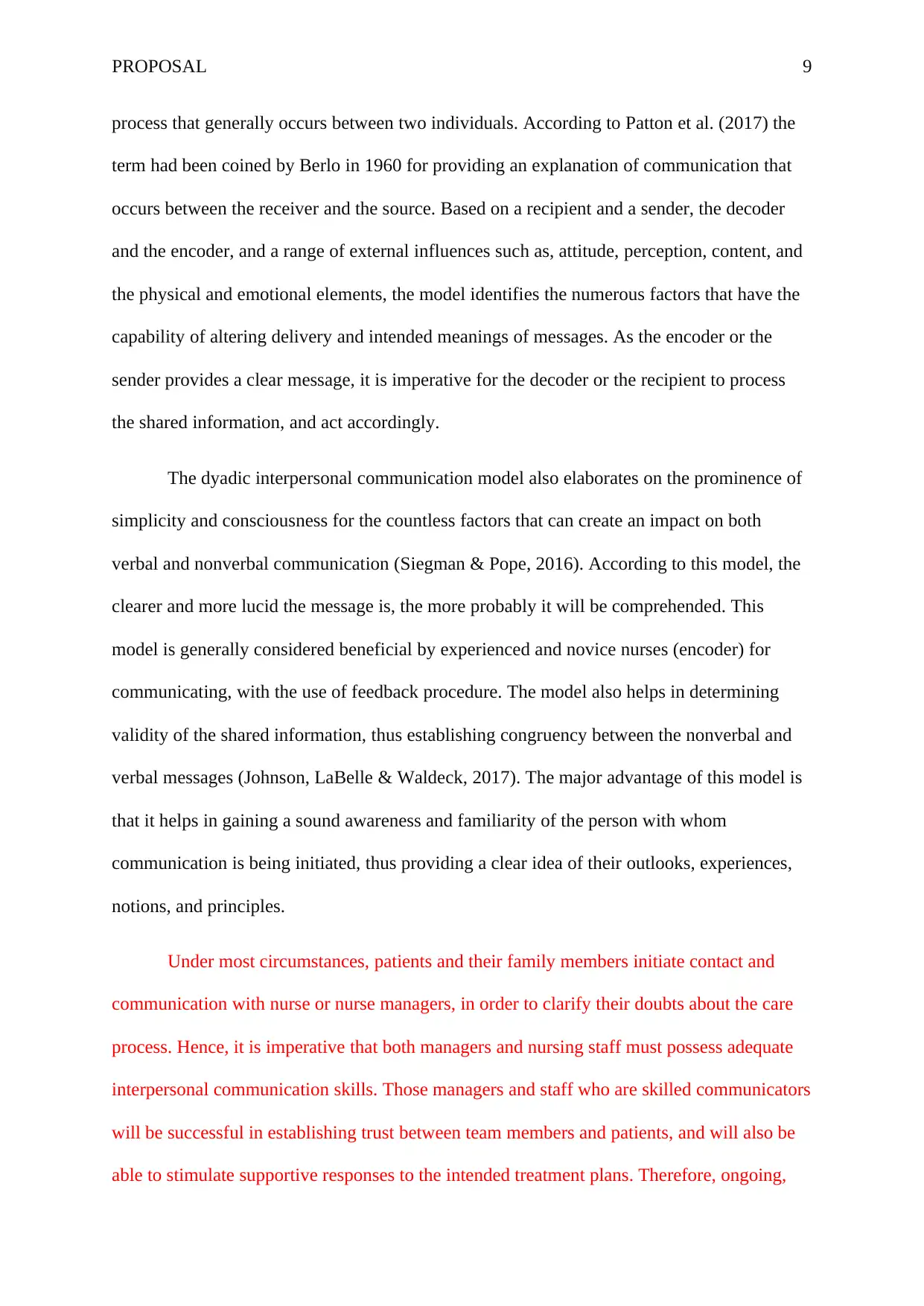
PROPOSAL 9
process that generally occurs between two individuals. According to Patton et al. (2017) the
term had been coined by Berlo in 1960 for providing an explanation of communication that
occurs between the receiver and the source. Based on a recipient and a sender, the decoder
and the encoder, and a range of external influences such as, attitude, perception, content, and
the physical and emotional elements, the model identifies the numerous factors that have the
capability of altering delivery and intended meanings of messages. As the encoder or the
sender provides a clear message, it is imperative for the decoder or the recipient to process
the shared information, and act accordingly.
The dyadic interpersonal communication model also elaborates on the prominence of
simplicity and consciousness for the countless factors that can create an impact on both
verbal and nonverbal communication (Siegman & Pope, 2016). According to this model, the
clearer and more lucid the message is, the more probably it will be comprehended. This
model is generally considered beneficial by experienced and novice nurses (encoder) for
communicating, with the use of feedback procedure. The model also helps in determining
validity of the shared information, thus establishing congruency between the nonverbal and
verbal messages (Johnson, LaBelle & Waldeck, 2017). The major advantage of this model is
that it helps in gaining a sound awareness and familiarity of the person with whom
communication is being initiated, thus providing a clear idea of their outlooks, experiences,
notions, and principles.
Under most circumstances, patients and their family members initiate contact and
communication with nurse or nurse managers, in order to clarify their doubts about the care
process. Hence, it is imperative that both managers and nursing staff must possess adequate
interpersonal communication skills. Those managers and staff who are skilled communicators
will be successful in establishing trust between team members and patients, and will also be
able to stimulate supportive responses to the intended treatment plans. Therefore, ongoing,
process that generally occurs between two individuals. According to Patton et al. (2017) the
term had been coined by Berlo in 1960 for providing an explanation of communication that
occurs between the receiver and the source. Based on a recipient and a sender, the decoder
and the encoder, and a range of external influences such as, attitude, perception, content, and
the physical and emotional elements, the model identifies the numerous factors that have the
capability of altering delivery and intended meanings of messages. As the encoder or the
sender provides a clear message, it is imperative for the decoder or the recipient to process
the shared information, and act accordingly.
The dyadic interpersonal communication model also elaborates on the prominence of
simplicity and consciousness for the countless factors that can create an impact on both
verbal and nonverbal communication (Siegman & Pope, 2016). According to this model, the
clearer and more lucid the message is, the more probably it will be comprehended. This
model is generally considered beneficial by experienced and novice nurses (encoder) for
communicating, with the use of feedback procedure. The model also helps in determining
validity of the shared information, thus establishing congruency between the nonverbal and
verbal messages (Johnson, LaBelle & Waldeck, 2017). The major advantage of this model is
that it helps in gaining a sound awareness and familiarity of the person with whom
communication is being initiated, thus providing a clear idea of their outlooks, experiences,
notions, and principles.
Under most circumstances, patients and their family members initiate contact and
communication with nurse or nurse managers, in order to clarify their doubts about the care
process. Hence, it is imperative that both managers and nursing staff must possess adequate
interpersonal communication skills. Those managers and staff who are skilled communicators
will be successful in establishing trust between team members and patients, and will also be
able to stimulate supportive responses to the intended treatment plans. Therefore, ongoing,
⊘ This is a preview!⊘
Do you want full access?
Subscribe today to unlock all pages.

Trusted by 1+ million students worldwide
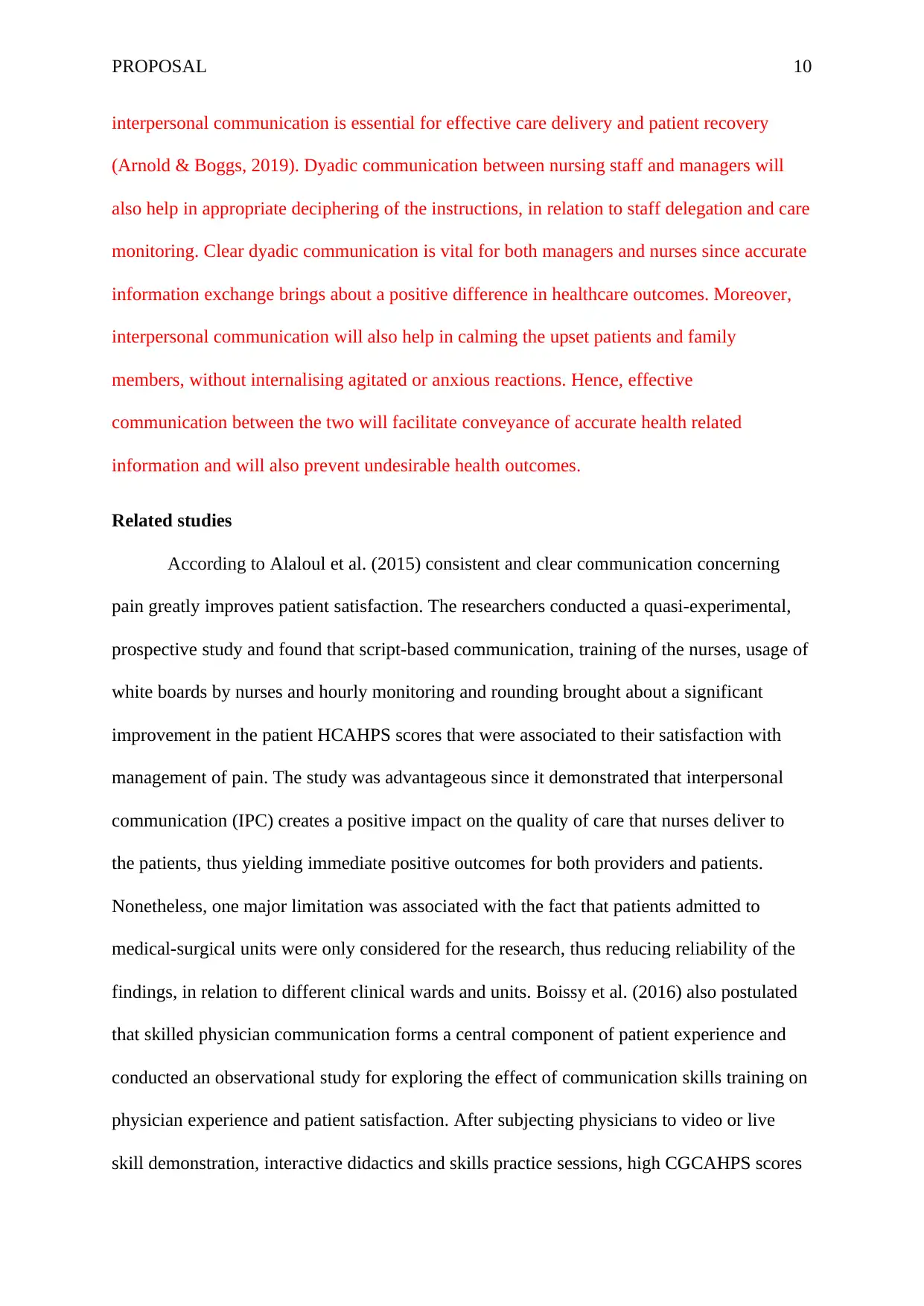
PROPOSAL 10
interpersonal communication is essential for effective care delivery and patient recovery
(Arnold & Boggs, 2019). Dyadic communication between nursing staff and managers will
also help in appropriate deciphering of the instructions, in relation to staff delegation and care
monitoring. Clear dyadic communication is vital for both managers and nurses since accurate
information exchange brings about a positive difference in healthcare outcomes. Moreover,
interpersonal communication will also help in calming the upset patients and family
members, without internalising agitated or anxious reactions. Hence, effective
communication between the two will facilitate conveyance of accurate health related
information and will also prevent undesirable health outcomes.
Related studies
According to Alaloul et al. (2015) consistent and clear communication concerning
pain greatly improves patient satisfaction. The researchers conducted a quasi-experimental,
prospective study and found that script-based communication, training of the nurses, usage of
white boards by nurses and hourly monitoring and rounding brought about a significant
improvement in the patient HCAHPS scores that were associated to their satisfaction with
management of pain. The study was advantageous since it demonstrated that interpersonal
communication (IPC) creates a positive impact on the quality of care that nurses deliver to
the patients, thus yielding immediate positive outcomes for both providers and patients.
Nonetheless, one major limitation was associated with the fact that patients admitted to
medical-surgical units were only considered for the research, thus reducing reliability of the
findings, in relation to different clinical wards and units. Boissy et al. (2016) also postulated
that skilled physician communication forms a central component of patient experience and
conducted an observational study for exploring the effect of communication skills training on
physician experience and patient satisfaction. After subjecting physicians to video or live
skill demonstration, interactive didactics and skills practice sessions, high CGCAHPS scores
interpersonal communication is essential for effective care delivery and patient recovery
(Arnold & Boggs, 2019). Dyadic communication between nursing staff and managers will
also help in appropriate deciphering of the instructions, in relation to staff delegation and care
monitoring. Clear dyadic communication is vital for both managers and nurses since accurate
information exchange brings about a positive difference in healthcare outcomes. Moreover,
interpersonal communication will also help in calming the upset patients and family
members, without internalising agitated or anxious reactions. Hence, effective
communication between the two will facilitate conveyance of accurate health related
information and will also prevent undesirable health outcomes.
Related studies
According to Alaloul et al. (2015) consistent and clear communication concerning
pain greatly improves patient satisfaction. The researchers conducted a quasi-experimental,
prospective study and found that script-based communication, training of the nurses, usage of
white boards by nurses and hourly monitoring and rounding brought about a significant
improvement in the patient HCAHPS scores that were associated to their satisfaction with
management of pain. The study was advantageous since it demonstrated that interpersonal
communication (IPC) creates a positive impact on the quality of care that nurses deliver to
the patients, thus yielding immediate positive outcomes for both providers and patients.
Nonetheless, one major limitation was associated with the fact that patients admitted to
medical-surgical units were only considered for the research, thus reducing reliability of the
findings, in relation to different clinical wards and units. Boissy et al. (2016) also postulated
that skilled physician communication forms a central component of patient experience and
conducted an observational study for exploring the effect of communication skills training on
physician experience and patient satisfaction. After subjecting physicians to video or live
skill demonstration, interactive didactics and skills practice sessions, high CGCAHPS scores
Paraphrase This Document
Need a fresh take? Get an instant paraphrase of this document with our AI Paraphraser
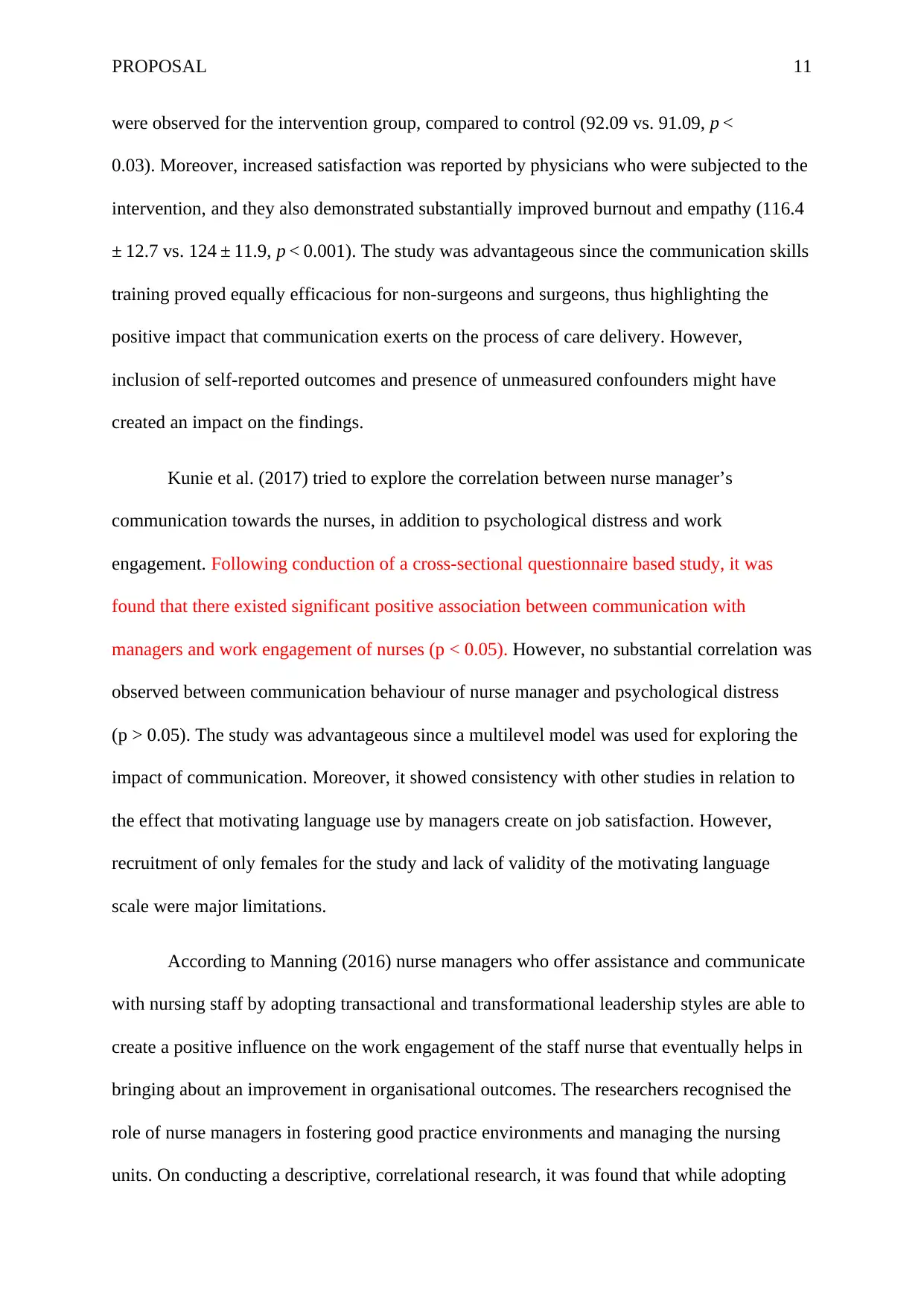
PROPOSAL 11
were observed for the intervention group, compared to control (92.09 vs. 91.09, p <
0.03). Moreover, increased satisfaction was reported by physicians who were subjected to the
intervention, and they also demonstrated substantially improved burnout and empathy (116.4
± 12.7 vs. 124 ± 11.9, p < 0.001). The study was advantageous since the communication skills
training proved equally efficacious for non-surgeons and surgeons, thus highlighting the
positive impact that communication exerts on the process of care delivery. However,
inclusion of self-reported outcomes and presence of unmeasured confounders might have
created an impact on the findings.
Kunie et al. (2017) tried to explore the correlation between nurse manager’s
communication towards the nurses, in addition to psychological distress and work
engagement. Following conduction of a cross-sectional questionnaire based study, it was
found that there existed significant positive association between communication with
managers and work engagement of nurses (p < 0.05). However, no substantial correlation was
observed between communication behaviour of nurse manager and psychological distress
(p > 0.05). The study was advantageous since a multilevel model was used for exploring the
impact of communication. Moreover, it showed consistency with other studies in relation to
the effect that motivating language use by managers create on job satisfaction. However,
recruitment of only females for the study and lack of validity of the motivating language
scale were major limitations.
According to Manning (2016) nurse managers who offer assistance and communicate
with nursing staff by adopting transactional and transformational leadership styles are able to
create a positive influence on the work engagement of the staff nurse that eventually helps in
bringing about an improvement in organisational outcomes. The researchers recognised the
role of nurse managers in fostering good practice environments and managing the nursing
units. On conducting a descriptive, correlational research, it was found that while adopting
were observed for the intervention group, compared to control (92.09 vs. 91.09, p <
0.03). Moreover, increased satisfaction was reported by physicians who were subjected to the
intervention, and they also demonstrated substantially improved burnout and empathy (116.4
± 12.7 vs. 124 ± 11.9, p < 0.001). The study was advantageous since the communication skills
training proved equally efficacious for non-surgeons and surgeons, thus highlighting the
positive impact that communication exerts on the process of care delivery. However,
inclusion of self-reported outcomes and presence of unmeasured confounders might have
created an impact on the findings.
Kunie et al. (2017) tried to explore the correlation between nurse manager’s
communication towards the nurses, in addition to psychological distress and work
engagement. Following conduction of a cross-sectional questionnaire based study, it was
found that there existed significant positive association between communication with
managers and work engagement of nurses (p < 0.05). However, no substantial correlation was
observed between communication behaviour of nurse manager and psychological distress
(p > 0.05). The study was advantageous since a multilevel model was used for exploring the
impact of communication. Moreover, it showed consistency with other studies in relation to
the effect that motivating language use by managers create on job satisfaction. However,
recruitment of only females for the study and lack of validity of the motivating language
scale were major limitations.
According to Manning (2016) nurse managers who offer assistance and communicate
with nursing staff by adopting transactional and transformational leadership styles are able to
create a positive influence on the work engagement of the staff nurse that eventually helps in
bringing about an improvement in organisational outcomes. The researchers recognised the
role of nurse managers in fostering good practice environments and managing the nursing
units. On conducting a descriptive, correlational research, it was found that while adopting
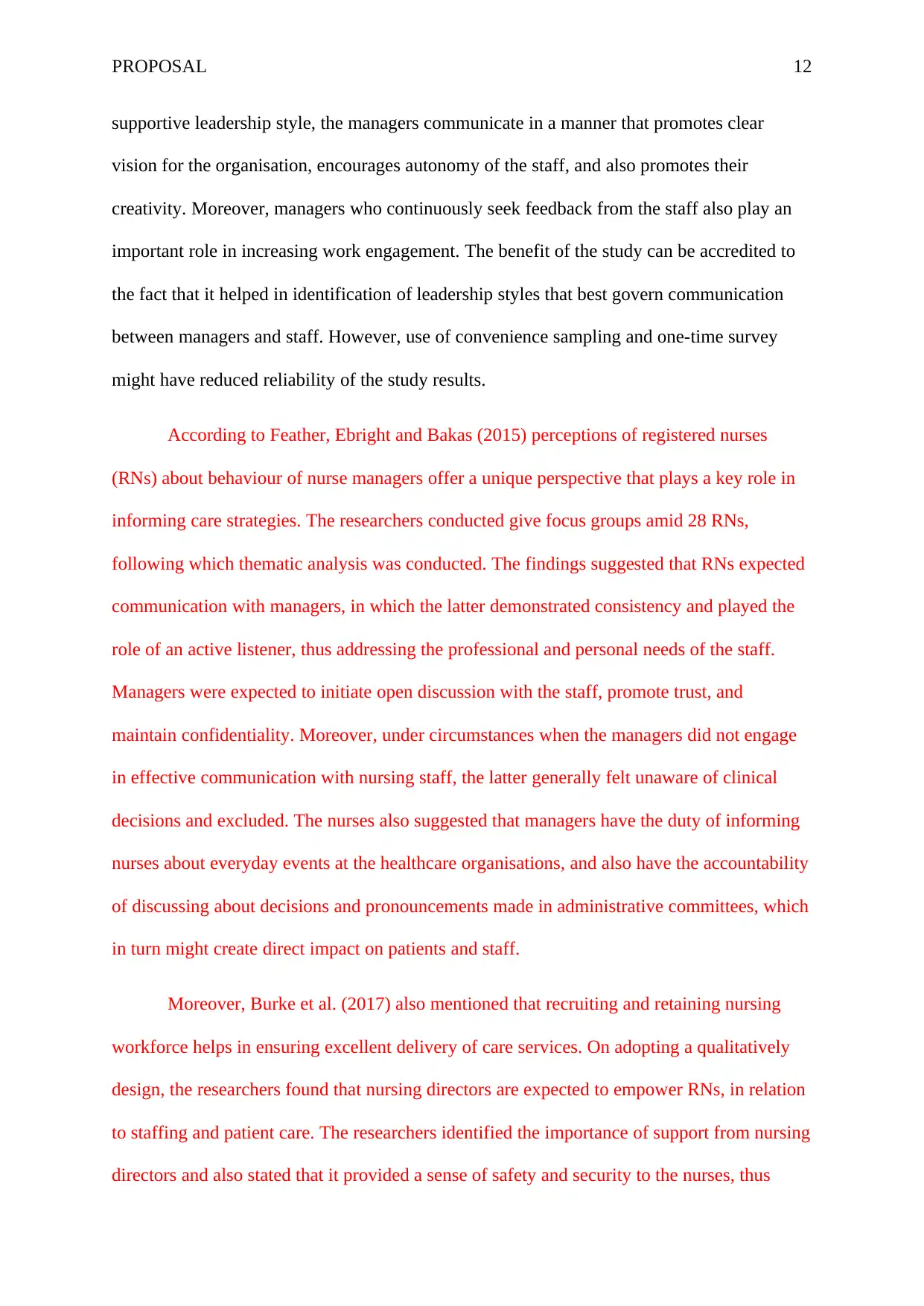
PROPOSAL 12
supportive leadership style, the managers communicate in a manner that promotes clear
vision for the organisation, encourages autonomy of the staff, and also promotes their
creativity. Moreover, managers who continuously seek feedback from the staff also play an
important role in increasing work engagement. The benefit of the study can be accredited to
the fact that it helped in identification of leadership styles that best govern communication
between managers and staff. However, use of convenience sampling and one-time survey
might have reduced reliability of the study results.
According to Feather, Ebright and Bakas (2015) perceptions of registered nurses
(RNs) about behaviour of nurse managers offer a unique perspective that plays a key role in
informing care strategies. The researchers conducted give focus groups amid 28 RNs,
following which thematic analysis was conducted. The findings suggested that RNs expected
communication with managers, in which the latter demonstrated consistency and played the
role of an active listener, thus addressing the professional and personal needs of the staff.
Managers were expected to initiate open discussion with the staff, promote trust, and
maintain confidentiality. Moreover, under circumstances when the managers did not engage
in effective communication with nursing staff, the latter generally felt unaware of clinical
decisions and excluded. The nurses also suggested that managers have the duty of informing
nurses about everyday events at the healthcare organisations, and also have the accountability
of discussing about decisions and pronouncements made in administrative committees, which
in turn might create direct impact on patients and staff.
Moreover, Burke et al. (2017) also mentioned that recruiting and retaining nursing
workforce helps in ensuring excellent delivery of care services. On adopting a qualitatively
design, the researchers found that nursing directors are expected to empower RNs, in relation
to staffing and patient care. The researchers identified the importance of support from nursing
directors and also stated that it provided a sense of safety and security to the nurses, thus
supportive leadership style, the managers communicate in a manner that promotes clear
vision for the organisation, encourages autonomy of the staff, and also promotes their
creativity. Moreover, managers who continuously seek feedback from the staff also play an
important role in increasing work engagement. The benefit of the study can be accredited to
the fact that it helped in identification of leadership styles that best govern communication
between managers and staff. However, use of convenience sampling and one-time survey
might have reduced reliability of the study results.
According to Feather, Ebright and Bakas (2015) perceptions of registered nurses
(RNs) about behaviour of nurse managers offer a unique perspective that plays a key role in
informing care strategies. The researchers conducted give focus groups amid 28 RNs,
following which thematic analysis was conducted. The findings suggested that RNs expected
communication with managers, in which the latter demonstrated consistency and played the
role of an active listener, thus addressing the professional and personal needs of the staff.
Managers were expected to initiate open discussion with the staff, promote trust, and
maintain confidentiality. Moreover, under circumstances when the managers did not engage
in effective communication with nursing staff, the latter generally felt unaware of clinical
decisions and excluded. The nurses also suggested that managers have the duty of informing
nurses about everyday events at the healthcare organisations, and also have the accountability
of discussing about decisions and pronouncements made in administrative committees, which
in turn might create direct impact on patients and staff.
Moreover, Burke et al. (2017) also mentioned that recruiting and retaining nursing
workforce helps in ensuring excellent delivery of care services. On adopting a qualitatively
design, the researchers found that nursing directors are expected to empower RNs, in relation
to staffing and patient care. The researchers identified the importance of support from nursing
directors and also stated that it provided a sense of safety and security to the nurses, thus
⊘ This is a preview!⊘
Do you want full access?
Subscribe today to unlock all pages.

Trusted by 1+ million students worldwide
1 out of 29
Related Documents
Your All-in-One AI-Powered Toolkit for Academic Success.
+13062052269
info@desklib.com
Available 24*7 on WhatsApp / Email
![[object Object]](/_next/static/media/star-bottom.7253800d.svg)
Unlock your academic potential
Copyright © 2020–2025 A2Z Services. All Rights Reserved. Developed and managed by ZUCOL.





